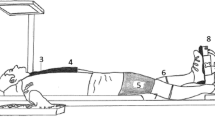Summary
Venous blood samples were obtained from either exercising (n=9) or nonexercising (n=8) hindlimb during a progressive isotonic exercise in rabbits anesthetized with urethane and chloralose. Each experimental session consisted of 5-min non-exercise periods alternated with 6-min exercise periods, followed by a 10-min postexercise period. During each exercise period, stimulation of the distal stump of the right sciatic nerve at 1 Hz induced plantar flexions which lifted loads comparable to 2, 5, 8, 30, or 50% of an afterload at which only an isometric tension developed. Free-flowing venous blood samples were obtained before the first exercise period, during the last minute of each exercise period, and 10 min following the last exercise session. Increases in [Na+], [K+] and lactate concentration were obtained in blood from active limbs. Only lactate concentration increased in blood from non-exercising limbs, while [K+] decreased slightly. Inferences concerning the vascular volume response to this protocol would be quite different depending on the blood sampling site. Changes in blood from inactive tissue, further, may indicate only saturation of homeostatic mechanisms which normally compensate for vascular volume alterations initiated in active tissue.
Similar content being viewed by others
References
Ahlborg G, Hagenfeldt L, Wahren J (1975) Substrate utilization by inactive leg during one-leg or arm exercise. J Appl Physiol 39: 718–723
Astrand P, Rodahl K (1977) Textbook of Work Physiology. McGraw-Hill, New York
Daniel WW (1978) Biostatistics. Wiley and Sons, New York
Grimby C (1965) Renal clearances during prolonged supine exercise at different loads. J Appl Physiol 20: 1294–1298
Hirche H, Schumacher E, Hageman H (1980) Extracellular K+ concentration and K+ balance of the gastrocnemius muscle of the dog during exercise. Pflügers Arch 387: 231–237
Hnik P, Kriz N, Vyskocil F, Smiesko V, Mejsnar J, Ujec E, Holas M (1973) Work induced potassium changes in muscle venous effluent blood measured by ion-specific electrodes. Pflügers Arch 338: 177–181
Hnik P, Vyskocil F, Kriz N, Holas M (1972) Work-induced increase of extracellular potassium concentration in muscle measured by ion-specific electrodes. Brain Res 40: 559–562
Liu MS, Sharma C (1981) Glycolytic enzyme activities in normal and diabetic dog livers during endotoxic shock. Am J Physiol 240: R10-R15
Lundvall JS, Mellander S, Westling H, White T (1972) Fluid transfer between blood and tissues during exercise. Acta Physiol Scand 85: 258–269
Poortmans JR, Bossche JD, Leclercq R (1978) Lactate uptake by inactive forearm during progressive leg exercise. J Appl Physiol 45: 835–839
Rowell LB, Kraning KK, Evans TO, Kennedy JW, Blackman J, Kusmi F (1966) Splanchnic removal of lactate and pyruvate during exercise in man. J Appl Physiol 21: 1773–1783
Saltin B, Sjogaard G, Gaffney FA, Rowell LB (1981) Potassium, lactate and water fluxes in human quadriceps muscle during static contractions. Circ Res [Suppl I] 48: 118–124
Senay LC, Jr, Pivarnik JM (1985) Fluid shifts during exercise. Exercise Sports Sci Rev 13 [in press]
Spitzer JJ (1975) Effect of lactate infusion on myocardial FFA metabolism in diabetic dogs. Am J Physiol 229: 973–976
Stainsby WW, Welch H (1966) Lactate metabolism of contracting dog skeletal muscle in situ. Am J Physiol 211: 177–183
Tibes U, Hemmer B, Schweigart U, Boning D, Fotescu D (1974) Exercise acidosis as cause of electrolyte changes in femoral venous blood of trained and untrained men. Pflügers Arch 347: 145–158
Tibes U, Hemmer B, Boning O, Schweigart U (1976) Relationships of femoral venous [K+], [H+], PO2, osmolality and [orthophosphate] with heart rate, ventilation and leg blood flow during bicycle exercise in athletes and non-athletes. Eur J Appl Physiol 35: 201–214
Tibes U, Haberkorn-Buteindeisch E, Hammersen F (1977a) Effect of concentration on lymphatic, venous and tissue electrolytes and metabolytes in rabbit skeletal muscle. Pflügers Arch 368: 195–202
Tibes U, Hemmer B, Boning D (1977b) Heart rate and ventilation in relation to venous [K+], osmolality, pH, PCO2, PO2, [orthophosphate], and [lactate] at transition from rest to exercise in athletes and nonathletes. Eur J Appl Physiol 36: 127–140
Winer BJ (1971) Statistical principles in experimental design. McGraw-Hill, New York
Author information
Authors and Affiliations
Rights and permissions
About this article
Cite this article
Gaebelein, C.J., Ladd, C.M. & Moudy, A.M. Changes in venous blood content from active and inactive hindlimb during isotonic exercise. Europ. J. Appl. Physiol. 53, 372–375 (1985). https://doi.org/10.1007/BF00422857
Accepted:
Issue Date:
DOI: https://doi.org/10.1007/BF00422857




